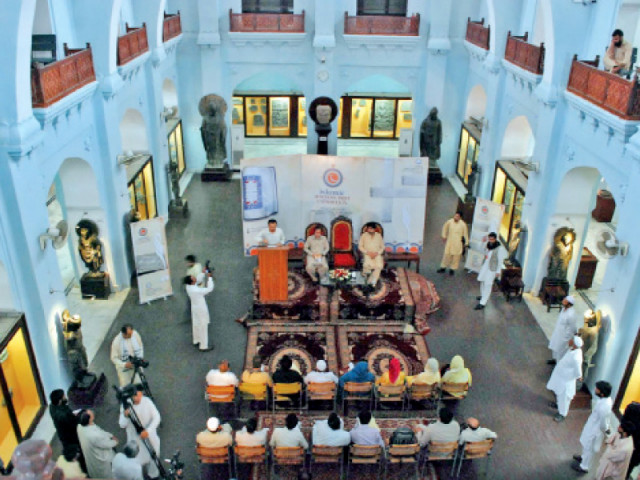Styles and fonts: Calligraphy comes alive at Peshawar Museum
A copy of the Quran dating back to 1100 is also being exhibited.

Over 105 ancient manuscripts were exhibited by the Khyber-Pakhtunkhwa Directorate of Archaeology at Peshawar Museum on Saturday. In the 10-day exhibition, Quranic manuscripts, Islamic calligraphy on stones, plates and bowls, silver and gold coins, inscribed wooden beads and boxes, along with Persian scripts, have been publicly displayed.
Among the remnants of history are silver and gold coins from the Ghurid dynasty and eras of Mughal emperors Akbar and Shah Jehan. It includes some of the oldest manuscripts written in the Naskh style of calligraphy by Fazle Hasan, courtier of Ibadullah Shah in 1271 AD, and the specimen of a document presented to Babur. A copy of the Quran dating back to 1100 is also being exhibited.
Specimens of Nastaliq calligraphy – the predominant style used in Persia – include an 18th century manuscript presented by a courtier to Mughal emperor Mohammad Shah, a copy of the Quran in Kufic calligraphy by Mirza Azizuddin, a copy by Faqir Qadir Bakhsh created in 1630, and a copy dating back to the era of Ahmad Shah Durrani with a Farsi translation in red ink and pages decorated in the Kashmiri style.
There is also a Quran published by Qazi Abdul Karim at Fazle Haq Lasani Press, Mumbai in 1897. Ten manuscripts at the exhibition show the Quran in Ghubar calligraphy on scrolls of yellow parchment dating back to 1224. In this distinctive style, smaller words are written within the bigger ones in the space provided by two enclosing lines.
Modern works of art are also on display at Peshawar Museum. A Quran written in the Nastaliq style by Salaiman Saeed in 2003, and white marble inscribed with Quranic verses donated by the Iranian consulate are up for public viewing.
“According to our survey, only 3% people in K-P have some understanding about archaeology,” said Archaeology Director Dr Abdul Samad while speaking at the opening ceremony of the exhibition. “We are taking the initiative to create awareness among the public about archaeology and the rich history of K-P.”
A majority of people in K-P believe that our museums contain only Gandharan statutes, said Samad, adding that most are not aware of the vast number of antiques and manuscripts they possess.
Adviser to K-P Chief Minister on Archaeology and Tourism Amjid Afridi said in his address that antiques from Peshawar Museum will be shifted to DI Khan, Kohat and Abbottabad museums once their construction is complete. He added that the exhibition is part of a campaign to create awareness among people and will be followed by an international conference on archaeology that will be arranged in Swabi in October.
Published in The Express Tribune, July 20th, 2014.













COMMENTS
Comments are moderated and generally will be posted if they are on-topic and not abusive.
For more information, please see our Comments FAQ